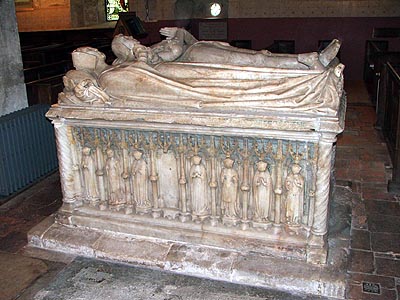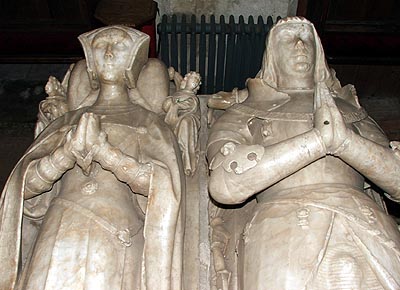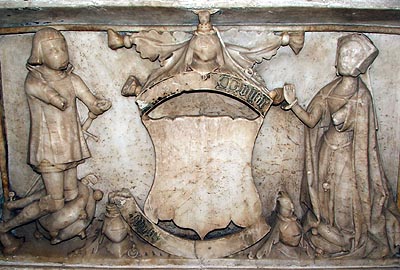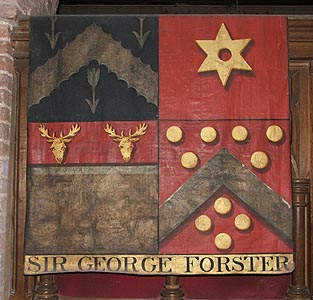 |
 |
|||
|
|
The noble altar tomb to Sir George Forster of Aldermaston House and Elizabeth his wife, the last representative and heir of the De la Mares, stands in the south chapel beneath the arch opening to the nave of Aldermaston Church. It is perhaps one of the most elegant and beautiful monuments of its period, and the wonderful attention shown to the most minute details and the excellence of every portion of the carving, make it a work of art worthy of the most careful examination, and of a more graphic description than the writer is able to confer upon it. The whole of the monument and effigies is composed of alabaster of the finest quality. The effigies are of large size: that of the lady, who occupies the right or south side, being six feet three inches; while that of her husband is six feet one inch in length. They rest on a table tomb six feet six inches in length by four feet three inches in breadth and three feet in height. This is set on a stone plinth standing up about four inches above the present floor, and with a margin of about seven inches all round the tomb. The lady
lies with her head on two pillows, supported by an angel on either side. She
has a kerchief in three folds round her hair, a long cloak carried in
graceful folds to her feet, and fastened by a chain with a rose as a pendant
across the chest. Her dress, also carried down to the feet, is cut with a
square opening below the throat, showing the upper part of an under garment,
or possibly a frill to the dress. This has slashed sleeves probably of
velvet, with lace frills partly covering the hands. Another thin vestment,
probably of silk, is shown, in some way fastened at the throat. She has a
heart-shaped amulet attached to a triple chain on the breast, and a girdle
round the waist, with a buckle or fastening on the left side, to which was
perhaps attached an ornament similar to that worn by the lady on the west
face of the tomb. Her hands, now mainly broken away, are clasped on her
breast. Her feet are shown enclosed in broad-toed shoes similar to those of
her husband. A little dog wearing a collar is introduced on the north side,
tugging at the bottom of her cloak. By her side lies her husband in complete
armour. His head is bare, and rests on his tilting helm with the hind's head
bearing a collar with chain and fetterlock attached as the crest. A cable
band is carried round below the crest, and to this is attached the mantling,
no doubt of silk, and in this instance unusually large. It is spread out in
a very elegant fashion, the folds with two tassels on either side being
carried down nearly to the waist on each side of the knight. The interior of
the helmet is shown with the folds of the material, doubtless silk, forming
the lining, probably to prevent the chafing of the metal. A very pretty
border is displayed on the lower rim of the helmet, and the buckle with
which it was fastened to the armour is also portrayed. The effigy presents
us with a most complete specimen of the armour of this Transitional period.
He has the steel cuirass, with the raised epaulieres fastened by a buckle on
each side. The The table tomb is divided on the north and south sides into eight compartments, with beautiful crocketed double canopies and central finial to each, and with a banded shaft forming a division between each compartment. On the north side are eight figures of knights, all in plate armour and varied in their attitudes. They all carry a shield on the left arm fastened by a strap over the right shoulder. The first and fifth from the east hold the sword in their hands; the others have their swords in the scabbards at their sides. The first, third, fifth and sixth have flat caps probably with plumes, the others being bareheaded. The western one is the most remarkable: he is represented as cross-legged and carrying a tilting helm in his right hand. The position of the hands is varied in each instance. The armour of the several figures is a miniature imitation of that of the effigy of Sir George. On the east side are three similar canopied compartments. The central one is now unoccupied, while in that on either side is the figure of a knight similar to those on the north1. On the south side are eight compartments similar to those on the north. There has been a female figure within each, but the fifth from the east has been removed. The effigies are all slightly varied in their attire and the pose of their hands, etc; but they also are, in the main, miniature representations of the figure of the Lady Elizabeth above them.
On the west side, within a rectangular panel, is a large armorial shield from which the tinctures have disappeared. It has formerly been surrounded by a circular frame or garter, but the sides have been broken off. There has been a raised inscription thrown out by colouring, of which the words "Monsyr Forster" alone remain. Above the shield is a tilting helm with the crest, probably the hind's head with a ducal crown round the collar and the chain and fetterlock attached to it. There is the flowing mantling fastened by a cable band to the upper part, and spread out in four pieces with large tassels at the terminations. On the right (south) kneels, on two cushions, a lady with right hand raised. Her costume is similar to that of the main effigy, and she has a girdle round the waist, with a circular object attached to it by a chain. At her feet is a helmet with mantling and goat's head for a crest.
It has been thought by some that the figures round the tomb represent the children of Sir George and his lady, and the statement of Leland, in his notice of Sir George and Lady Elizabeth, that they had twenty children would support this contention. In addition to the kneeling figures at the west face, whom we assume to be the eldest son and his lady, there are, including the missing figures, eleven more sons and eight daughters, which would make up the required number. It may, however, be possible that Leland, who probably saw this monument soon after its erection, may have jumped to the conclusion that these figures represented the children of the deceased, and not, as we usually interpret them, 'weepers'2. In most of the series assumed to be 'weepers,' we find religious personages introduced, and we should have expected this to be the case here where there are so large a number of figures. It is possible, therefore, that the assertion that they are the portraits of the members of the family is correct. At the angles of the monument are engaged cable shafts of Italian character, and round the verge of the upper slab on which the figures rest is the following inscription, commencing at the west end of the south side: "Here lieth Sir George Forster knight son and heir of Humphrey Forster esquire cousin and one of the heirs of Sir Stephen Popham knight and Elizabeth wife of the same Sir George daughter and heir of John De la Mare esquire son and heir of Thomas de la Mare knight which Elizabeth died the vii day of December in the year of Our lord God MCCCCCXXVI and which Sir George die[d] in the year of Out Lord [blank]"
On the tie-beam across the chapel is an iron bracket and spike, on which is fixed a helmet and crest said to have belonged to Sir George Forster. It has been carefully examined, and is pronounced to belong mainly to the period of the commencement of the sixteenth century, the visor being possibly of rather later date. The crest, the hind's head, is of wood, and has been painted a delicate pink. It is somewhat worm-eaten, but otherwise in good preservation. Another of these wooden crests remains at Cobham Church, Kent, but it is believed they are very uncommon. The banner of Sir George Forster also hangs from the king-post above the tie-beam. It does not seem to be so early as his times. It has his name and the following armorial bearings: quarterly (1) Forster, (2) Harpsden, (3) Popham and (4) Zouch of Deene. Notes 1. Neale, in his notice of this monument, in the Views of Seats, states "that there are also at the foot three more son". Was this an assumption, or has that the figure been removed since his time? 2. In the Rutland Chapel, on the north side of the nave of St. George's Chapel, Windsor, is the monument of Sir George Manners, Lord Roos, and his lady, who was the daughter of the Duchess of Exeter, and niece of King Edward IV. She died in 1526, in the same year as the Lady Elizabeth Forster. This monument resembles in a remarkable manner the one at Aldermaston. The costumes of the main effigies are almost identical, and among the weepers or children is a small cross-legged knight corresponding with the figure at Aldermaston. Is it presumptuous to assume that these two monuments were executed by, or at any rate under the supervision of, the same artist? Slightly edited from 'Aldermaston Church, Berkshire' by Charles E Keyser MA FSA in the Archaeological Journal (1844).
|
|||
| © Nash Ford Publishing 2010. All Rights Reserved. | ||||



 Monument to Sir George &
Lady Forster
Monument to Sir George &
Lady Forster
 arm guards and elbow pieces of plate are clearly defined. The
haubergeon, of link mail, appears under the cuissarts or thigh pieces, which
are fastened by five buckles to the cuirass at the waist, and are folded
back in front. The legs are encased in mail, with large genouillieres or
knee guards. The sollerets are square-toed, and also of metal. Most of his
sword, which is suspended at his left side from a belt attached to the back
of the waist, is broken away. His gauntlets, also much damaged, lie on the
tomb by his left knee, while his dagger is laid by his right side. He does
not carry a shield; but on the cuirass on the right side is a loop, probably
of leather, for the strap carried over the right shoulder as a support to
the shield on the breast, as shown in the figures of the weepers below. His
feet rest on a buck or stag, both the antlers being now broken away. His
hands are bare, and clasped in the attitude of prayer on the breast. He
wears a very beautiful and remarkable collar of SS, with a portcullis and
Tudor rose pendant, on which his hands are resting. It is probable that some
colour and gilding was used to beautify parts at any rate of these figures,
and traces are still apparent on the head-dress of the lady and the collar
of SS of the knight.
arm guards and elbow pieces of plate are clearly defined. The
haubergeon, of link mail, appears under the cuissarts or thigh pieces, which
are fastened by five buckles to the cuirass at the waist, and are folded
back in front. The legs are encased in mail, with large genouillieres or
knee guards. The sollerets are square-toed, and also of metal. Most of his
sword, which is suspended at his left side from a belt attached to the back
of the waist, is broken away. His gauntlets, also much damaged, lie on the
tomb by his left knee, while his dagger is laid by his right side. He does
not carry a shield; but on the cuirass on the right side is a loop, probably
of leather, for the strap carried over the right shoulder as a support to
the shield on the breast, as shown in the figures of the weepers below. His
feet rest on a buck or stag, both the antlers being now broken away. His
hands are bare, and clasped in the attitude of prayer on the breast. He
wears a very beautiful and remarkable collar of SS, with a portcullis and
Tudor rose pendant, on which his hands are resting. It is probable that some
colour and gilding was used to beautify parts at any rate of these figures,
and traces are still apparent on the head-dress of the lady and the collar
of SS of the knight.
 On the opposite (north) side,
also kneeling on two cushions, is the figure of a knight in armour somewhat
different to that of Sir George. He has a garment open at the sides over the
armour and down to the thighs - the tabard. His hands are broken away. He is
bareheaded, and his helmet with mantling and the hind's head crest, similar
to that under the head, is placed on the ground in front of him. It seems
probable that these two figures on the west face of the tomb represent Sir
Humphrey Forster, the eldest son and heir of Sir George, and his wife, the
daughter of Lord Sandys of the Vyne, who put in the armorial shields in old
glass now placed in the north window of the nave facing this monument.
On the opposite (north) side,
also kneeling on two cushions, is the figure of a knight in armour somewhat
different to that of Sir George. He has a garment open at the sides over the
armour and down to the thighs - the tabard. His hands are broken away. He is
bareheaded, and his helmet with mantling and the hind's head crest, similar
to that under the head, is placed on the ground in front of him. It seems
probable that these two figures on the west face of the tomb represent Sir
Humphrey Forster, the eldest son and heir of Sir George, and his wife, the
daughter of Lord Sandys of the Vyne, who put in the armorial shields in old
glass now placed in the north window of the nave facing this monument. The last date is left in
blank, and no provision had been made to complete the inscription in raised
letters, as in the rest of the legend. There are traces of colouring between
the letters. The canopies above the smaller figures have been richly painted
with blue and gold, and the backs of the several compartments have been
similarly decorated. The monument is known to have been erected in the
lifetime of Sir George, who died in 1533, and may justly claim to be one of
the finest examples of monumental art to be found in any parish church in
England.
The last date is left in
blank, and no provision had been made to complete the inscription in raised
letters, as in the rest of the legend. There are traces of colouring between
the letters. The canopies above the smaller figures have been richly painted
with blue and gold, and the backs of the several compartments have been
similarly decorated. The monument is known to have been erected in the
lifetime of Sir George, who died in 1533, and may justly claim to be one of
the finest examples of monumental art to be found in any parish church in
England.